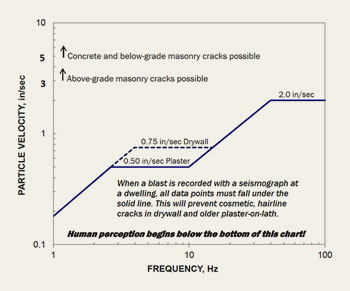Blasting In Ohio’s Quarries And Surface Coal Mines
On a typical workday in Ohio, over a quarter million pounds of explosives are safely detonated in quarries and surface coal mines.
 |
Ohio Department of Natural Resources Columbus 614.265.6633 | New Philadelphia 330.339.2207 |
The word “blasting” often conjures up visions of destruction - mushroom clouds, gigantic craters, high-rise buildings collapsing, bridges falling and cars exploding. However, on a typical workday in Ohio, over a quarter million pounds of explosives are safely detonated in quarries and surface coal mines. The Ohio Department of Natural Resources, Division of Mineral Resources Management is the agency responsible for regulating the environmental effects of mining and blasting. This article will address some of the commonly asked questions and misconceptions regarding blasting.
Why is blasting necessary?
Blasting is the most cost effective way to fracture rock so that it can be excavated by earth-moving equipment. This, in turn, reduces the costs of building materials, such as gravel and concrete, energy produced from coal, and many other products derived from limestone, coal and other minerals.
Is dynamite still used?
People living near quarries and coal mines often express concern about “the dynamiting going on over there.” In fact, dynamite, a nitroglycerin-based explosive, is rarely used today in Ohio’s quarries and surface coal mines. The most widely used explosives are ANFO, emulsions, and ANFO/emulsion blends. ANFO is a mixture of ammonium nitrate (AN) and fuel oil (FO). The AN is in the form of a prill (small, bead-like pellet), which absorbs the fuel oil. An emulsion is essentially a waterproof version of ANFO. Both are far less hazardous than dynamite and break more rock per unit of cost.
How far do fractures extend from a blasthole?
Blastholes are normally drilled vertically and arranged in a grid pattern. Typical blasthole diameters range from two to seven inches in quarries and five to nine inches in surface coal mines, with typical depths from 10 to 70 feet. Upon detonation, fracturing of rock generally occurs no greater than 20 to 30 feet from any blasthole, depending largely upon hole diameter and the densities of the rock and explosive. A common misconception is that fracturing extends far beyond the mine property - even miles from the blast site. If this were true, the blastholes could be placed much farther apart than the commonly used spacing of six to 18 feet in quarries and 12 to 25 feet in surface coal mines, and blasting would be much more economical since less drilling and explosives would be necessary.
AAnother common misconception associated with blasting is that significant fracturing occurs far below the bottom of a blasthole. In fact, most of the gas pressure forces created by the detonation of the explosive radiate outward along the length of the cylindrical blasthole. Depending upon the hole diameter, type of explosive and nature of the rock, gas-pressure forces below the bottom of the blasthole are comparatively minimal and fracturing of rock is generally limited to several feet. In most surface coal mines, a buffer of only three to five feet between the bottom of the blastholes and the top of the coal seam adequately protects the coal (which is brittle to begin with) from being fractured and contaminated by the rock material immediately above it. Failure to protect the coal from fracturing can increase the cost of cleaning the coal and significantly reduce the mine operator’s profits.
What causes ground vibration and how is it measured?
When a blast detonates, some of the explosive energy not utilized in breaking rock travels through the ground in all directions as wave motion, similar to the ripple created in a pond when a stone hits the water. This wave motion, or ground vibration, travels mainly along the surface at speeds of 5,000 to 20,000 feet per second, depending upon the density and thickness of the rock and soil. Its energy decreases rapidly with distance from the blast and normally decays to levels undetectable by humans beyond several thousand feet. Because explosives are expensive and vibration represents wasted energy, it is to the blaster’s advantage to utilize as much of the energy as possible in fragmentation, thereby minimizing vibration.
Blasting seismographs are used to measure ground vibration in terms of particle velocity, which is the speed at which each particle in the ground oscillates as the wave motion passes. This would be similar to measuring the speed of a fishing bobber in a pond as it moves up and down when a ripple passes under it. Particle velocity is measured in inches per second, but beyond several hundred feet from a blast the actual movement of the ground, or displacement, is generally only a tiny fraction of an inch, about the thickness of a piece of paper, or less. So it is important to understand that a particle velocity reading expressed in inches per second refers to the speed at which the ground moved, and not the amount of movement.
How is ground vibration controlled?
Blasters control ground vibration mainly by limiting the weight of explosives detonated within any instant of time. They do this by using millisecond delay detonators (blasting caps) to separate the firing time of each hole from adjacent holes. In a typical 50-hole blast, the result would be 50 smaller and separate explosions instead of one large blast. A common misconception is that the number of blastholes determines the resulting intensity of vibration. However, given the same charge-weight per delay and the same distance to a house, a 100-hole blast can be designed to produce no more vibration than a 10-hole blast.
| Figure 1 | ||
| AIRBLAST EFFECTS | ||
| dB | PSI | |
| 180 | 3.0 | Conventional structures severely damaged Plaster cracks at 176 dB |
| 170 | 1.0 | Most windows break at 171 dB |
| 160 | 0.3 | |
| 150 | 0.1 | Some windows may break at 151 dB |
| 140 | 0.03 | Exceeded by strong wind gusts in Ohio |
| 130 | 0.009 | DMRM limit is 133 dB |
| 120 | 0.003 | Startling to people inside homes |
| 100 | 3x10-4 | |
| 80 | 3x10-5 | |
| 60 | 3x10-6 | Conversational speech |
Airblast is usually measured with a special microphone connected to the same type of seismograph that measures ground vibration. The most common units of airblast measurement are pounds per square inch (psi) and the decibel (dB), which is based on a logarithmic sound-pressure scale related to human hearing. The threshold of hearing begins at zero decibels. An increase of six decibels represents a doubling of air pressure. As an example, an airblast measured at 126 dB would have twice the air pressure of an airblast at 120 dB. (See Figure 1 – Airblast Effects.)
How is airblast controlled?
Airblast is controlled mainly by the use of stemming material (drill cuttings or crushed stones that are shoveled back into the blasthole after the explosives have been loaded to a predetermined depth from the surface), and by not loading explosives into portions of holes with cracks, voids or mud seams. These techniques minimize the escape of gases and confine the explosive energy where it is needed to efficiently break rock.
What are the ground vibration and airblast limits?
| Figure 2 |
| GROUND VIBRATION LIMITS FOR OHIO COAL AND INDUSTRIAL MINERALS PERMITS |
 |
Ohio’s limits are based on extensive research by the former United States Bureau of Mines (USBM), which evaluated the effects of blast-induced ground vibration and airblast on residential structures. The limits were designed to prevent the most cosmetic type of damage--hairline cracks in drywall and older plaster-on-lath--even if the blasting is repeated on a daily basis for many years. The limits provide even greater protection to foundation walls, concrete slabs, wells and buried utilities.
Who may conduct blasting?
Only a certified blaster may conduct blasting in Ohio’s quarries and surface coal mines. To become certified, a blaster must obtain 2 years of blasting crew experience including on-thejob training, attend 40 hours of classroom training, and pass an exam covering blast design, safety, vibration control and monitoring, and state and federal blasting regulations. Once certified, a blaster must attend 24 hours of continuing education during every 3-year renewal period.
If the dishes rattle, is my home being damaged?
Even when blast vibrations are far below the legal limit, highly perceptible vibration can be experienced inside the home; windows and dishes might rattle, knickknacks and pictures might move or fall if not securely fastened, and hanging lamps might sway. These effects can be generated by ground vibration or airblast acting separately or together, and can last from one to three seconds or more, depending upon the distance from the blast, geologic influences and other factors. Despite these sometimes startling effects, there is no direct correlation between how a blast “feels” or sounds and its potential for causing structural damage to a home. In fact, cultural stresses (e.g., doors slamming, kids jumping, people pounding nails) and natural stresses (e.g., sunlight, wind, rain, temperature and humidity fluctuations and changes in soil moisture) can place greater stresses on a home than legal blast vibrations.
